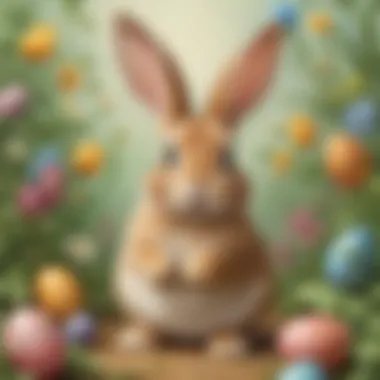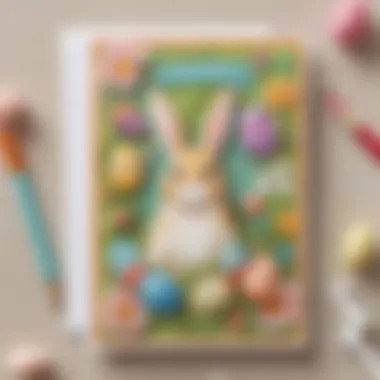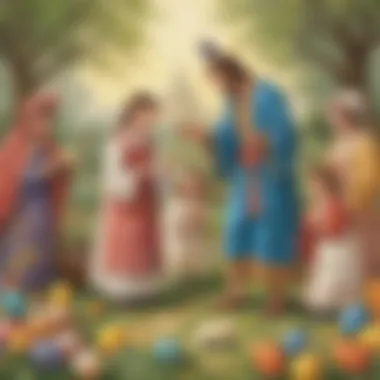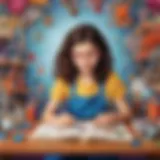Creative Easter Card Ideas for Everyone


Intro
Easter is more than just eggs and bunnies; it's an occasion that resonates with symbolism, creativity, and opportunities for bonding. The act of sending and receiving Easter cards can transform what might seem like an ordinary ritual into a vibrant, heartfelt experience that echoes the essence of this season. In this article, we delve into a variety of Easter cards that not only showcase eye-catching designs but also celebrate the warmth of personal connections.
Whether you're crafting a card with your little ones or hunting for the perfect store-bought treasure, there’s a world of creativity awaiting discovery. The unique themes can widen a child's understanding of traditions, while DIY options ignite their imaginative sparks. The art of card-making doesn't merely serve as a prelude to Easter celebrations; it creates pathways for interactive learning and exploration.
Throughout this piece, we will touch upon significant aspects like interactive learning through card creation, sew together educational themes, and dive into practical tips designed for parents and educators. Moreover, we’ll explore hands-on projects to enhance creativity. Following these discussions, one might just find that sending and making Easter cards can be a delightful journey that children will cherish long after the season ends.
Foreword to Easter Cards
Easter, a holiday celebrated worldwide, carries a rich tapestry of customs and traditions. Among these traditions, the exchange of Easter cards stands out. This practice may seem simple at first glance, but its significance stretches far beyond a mere written greeting.
Easter cards offer a unique opportunity to express affection towards loved ones while also celebrating cultural heritage. For parents and educators, these cards can be a gateway to teach children about the values of kindness, creativity, and connection.
Historical Context
The history of Easter cards stretches back over a century. The first known Easter card dates to the early 19th century, originating in England. At that time, people used intricate designs, poorly printed images, and lengthy poems to send greetings of goodwill. With growing literacy and advances in printing, the concept of sending illustrated cards became more popular. By the late 19th century, companies like Hunt & Co. were producing Easter cards in mass, branding this form of communication into a beloved tradition.
This historical journey doesn’t just stop at production; it reflects a broader social evolution. As Easter gained prominence, so too did the diversity of card designs. Different cultures infused their customs into the creation of these cards, resulting in unique styles that still flourish today.
Cultural Significance of Easter Cards
Easter cards come to symbolize various themes, such as renewal, hope, and togetherness. When you look closely, it becomes apparent that these cards are wrapped in the essence of cultural storytelling. Depending on where they are sent from or to, the illustrations might showcase vibrant flowers, playful bunnies, or even religious symbols like the cross. Each element tells a story.
"Easter cards are not just items of commerce; they are artifacts of our shared experiences, embodying memories, wishes, and traditions."
In different countries, the customs surrounding Easter cards can vary quite a bit. For instance, in the United States, the focus leans heavily towards pastel shades and playful designs, reflecting the festive spirit of spring. Meanwhile, in Eastern European countries, intricate designs often boast deeper religious meanings, showcasing the importance of faith in the celebration.
Personal connections become even more pronounced with the spread of technology. Families can now create and send digital cards that echo these same traditions but add a modern twist. Little effort spent on designing these cards often yields substantial returns, fostering discussions among children about different cultures, beliefs, and values related to the Easter holiday.
In short, the world of Easter cards is a complex one, a blend of historical evolution and cultural significance that offers insights into human connection. It is important to recognize this history and cultural context, as they enrich our understanding of why these seemingly simple greetings carry such weight today.
Traditional Easter Card Designs
The charm of traditional Easter card designs lies in their rich symbolism and time-honored aesthetics that resonate through generations. These cards serve not just as simple greetings but as vessels carrying feelings, memories, and cultural traditions. Examination of traditional designs offers insight into the enduring nature of Easter celebrations, inspiring both nostalgia and creativity in recipients and senders alike.
Classic Imagery
Symbols of Easter
Symbols of Easter are pivotal in shaping the themes of traditional cards. Take, for example, the lamb, which signifies innocence and is often associated with rebirth. Using such symbols transforms a card into a meaningful vehicle for expressing thoughts and emotions. Classic symbols not only depict the spirit of the holiday but also encourage deeper reflection on its significance. For many, receiving a card adorned with a delicate illustration of a lily evokes memories of family gatherings and church services.
The unique feature of symbols is their ability to transcend language barriers; images speak volumes where words might falter. On the downside, sometimes these symbols can be cliché or misinterpreted, leading to confusion. Still, most people cherish their familiarity and warmth.
Color Schemes
Color schemes in Easter cards bring vibrancy to the celebration. The pastel palette is particularly synonymous with the holiday: soft pinks, light blues, gentle yellows, and leafy greens create a tranquil yet cheerful aura. These colors evoke the freshness of spring and resonate with feelings of renewal.
Using bright colors can capture attention immediately; they have a significant impact on mood and are often associated with happiness. However, overuse of color can clash, reducing the effectiveness of the design. Thus, striking a balance is essential, ensuring the card is pleasing to the eye while conveying the joyous spirit of Easter.


Messages and Wishes
Religious Messages
Religious messages hold a crucial place in traditional Easter card designs. They speak to the core of the holiday's significance, emphasizing themes of hope, resurrection, and renewal. Phrases like “He is risen!” encapsulate the essence of Easter and connect the card with its spiritual roots. These messages invite the recipient to reflect on deeper values and beliefs, fostering a sense of community.
A distinguishing feature of religious messages is their timelessness; they bear the weight of tradition while still resonating with modern audiences. However, one must be cautious, as not everyone shares the same beliefs. Cards featuring these messages can be exclusionary, which is a potential downside.
Cultural Messages
Cultural messages enhance the personal touch of Easter cards. They celebrate various traditions and practices associated with the holiday around the world. For instance, mentioning local customs like egg rolling or unique family traditions might make the card feel more individualized and relatable. Utilizing cultural references not only showcases diversity but also educates recipients about different ways people celebrate Easter.
The appeal of cultural messages lies in their ability to create connections. They remind us of the rich tapestry of human experience. However, there’s a risk of oversimplification, where cultural motifs might be misrepresented. Careful consideration of how these messages are crafted is essential to maintain authenticity.
"Easter cards are like windows to the past. They depict not just joy but also the lessons of community, culture, and faith wrapped in beautiful imagery."
Understanding the role of traditional designs in Easter cards deepens appreciation for the holiday's significance and heritage. Each design choice reflects a tradition rooted in love, connection, and joy, making them perfect for sharing with friends and family.
Contemporary Easter Card Designs
In today's world, the evolution of card designs reflects a blending of tradition and modern sensibility. Contemporary Easter cards stand out by incorporating innovative elements that resonate with a wider audience. The push towards unique aesthetics and personal touches illustrates how people desire more than just a standard card; they look for something that tells a story or conveys a message in a fresh way.
In this section, we explore two distinct themes prevalent in contemporary card designs: trendy themes, showcasing both minimalist aesthetics and whimsical art, and the rising trend of digital cards that offer distinct advantages and design tools for creativity. These aspects are crucial because they cater to different taste preferences and offer varied ways to connect with recipients.
Trendy Themes
Minimalist Aesthetics
Minimalist aesthetics emphasize simplicity and clarity. It's that clean, no-frills approach that manages to pack a punch with just a few elements. Card designs that embrace minimalism often use limited color palettes, straightforward typography, and ample white space to create a feeling of tranquility.
This style resonates well in the age where overconsumption is a concern, leading many to appreciate designs that reflect calmness and intentionality. Given the importance of meaningful gestures in card-giving, minimalist designs often convey sincerity without overwhelming the viewer. For example, a simple egg sketch in pastel colors can evoke the essence of Easter without every detail being overly complicated.
One significant benefit of minimalist aesthetics is the ease with which they can be achieved, even by those new to card-making. The focus on fewer elements means anyone can create a beautiful card without needing expert skills. However, it's worth noting that such simplicity can sometimes be perceived as too stark or lacking warmth.
Whimsical Art
Whimsical art adds a touch of playfulness to Easter cards, drawing inspiration from fairy tales and the lighthearted aspects of childhood. Characterized by bright colors, charming figures, and imaginative designs, these cards often tell a story or create a fantastical world that captivates both young and old.
Finding humor and joy in everyday scenarios is the hallmark of whimsical art. Greeting cards featuring bunnies painting eggs or chicks wearing hats can tickle the funny bone and lighten the mood. This spirited approach makes cards undeniably fun, allowing the sender to share joy and smiles, which is especially important during holiday seasons.
These cards can be an excellent choice for families with children, who can revel in the playful imagery together. Although whimsical art typically appeals to many, it might not resonate with everyone, as some may prefer a more traditional approach due to personal aesthetic choices.
Digital Cards
Advantages of E-Cards
Digital cards have gained popularity, especially as technology advances. They offer several advantages over traditional cards, the most notable being convenience. Those juggling busy schedules appreciate being able to design and send greetings instantly—no need for stamps or long shipping times.
E-cards can also be more environmentally friendly. Thus, people interested in sustainability often find e-cards appealing. Plus, many platforms offer stylish designs that rival printed cards, allowing users to select from a plethora of themes to fit their needs.
While E-cards are practical, some may feel that they lack the sentimental value of a physical card. The tactile experience of holding and opening a physical card can create lasting memories, something that may not translate in a digital format.


Design Tools for Digital Creation
The rise of design tools has made it easier than ever for anyone to create personalized digital Easter cards. Platforms like Canva or Adobe Spark offer user-friendly interfaces, allowing users, regardless of skill level, to experiment with layouts, fonts, and images. This democratization of design fosters creativity, enabling families to craft something truly unique.
A critical characteristic of these tools is their accessibility. No longer do users require extensive knowledge of graphic design; many templates are available, simplifying the process. This ease of use has empowered people to mirror their personal styles in their card-making endeavors.
Nevertheless, while digital tools have broadened creative opportunities, they can sometimes lead to formulaic designs that lack individuality. Furthermore, technological issues can frustrate users if they encounter software glitches or compatibility problems, which can dampen the entire card-creation process.
Creating Personalized Easter Cards
When it comes to celebrating Easter, personalized cards can make a world of difference. They’re not just pieces of paper; they carry emotions, memories, and messages that resonate with both the sender and the receiver. The beauty of personalized Easter cards lies in their capacity to reflect unique relationships, convey heartfelt sentiments, and showcase creativity. Ultimately, creating personalized cards is about capturing the essence of the Easter spirit in a way that feels intimate and genuine.
The Importance of Personalization
Building Connections
Building connections is one of the most important aspects of creating personalized Easter cards. It’s not merely about delivering a card; it’s about establishing and nurturing relationships through thoughtful gestures. Sending a personalized card can strengthen ties between family members, friends, and even coworkers. It shows that you care enough to put in the effort, and that resonates deeply.
The key characteristic of building connections through personalized cards is their emotional impact. Unlike store-bought cards that might feel generic, a personalized card tells a unique story. You might incorporate inside jokes, share favorite memories, or even include photos. This way, the receiver feels a special bond to the sender, reinforcing the connection.
However, there's a balance to strike. While excessive personalization can overwhelm the card, a well-thought-out design brings warmth and familiarity, making it a popular choice within this article.
Encouraging Creativity in Children
Encouraging creativity in children is another significant aspect of personalized Easter cards. Childhood is a blossoming phase filled with imagination, and what better way to spark this than with card-making? Not only does this activity unleash their creativity, but it also gives them a sense of ownership over their work, which is invaluable.
One of the standout features is how personalized cards become a canvas for self-expression. Kids can experiment with colors, stickers, stamps, and various materials, leaving their individual mark on every card they create. This process not only enhances their artistic skills but also promotes confidence and a sense of achievement.
While fostering creativity is essential, there's a slight caveat to consider. Sometimes, children might feel pressure to meet certain expectations or standards in crafting. Therefore, guiding them while allowing freedom is the way to go. This balance makes the idea of encouraging creativity in card-making not only beneficial but incredibly rewarding for the little ones.
DIY Card-Making Ideas
Material Options
When it comes to DIY card-making, material options are broad and varied, enriching the overall experience. The types of materials used can greatly influence not only the final product but also the card-making process itself. From traditional cardstock to recycled materials, the sky's the limit.
Key characteristics of material options include accessibility and versatility. Parents and educators can easily source materials from around the house or art supplies stores. This not only makes it an economical choice but also allows for a plethora of creative possibilities. Kids can use fabric scrap, buttons, ribbons, or even nature finds like pressed flowers, making every card one-of-a-kind.
That said, it's essential to know the unique features of each option. Some materials might require adult supervision, like scissors or glue, while others, like markers or crayons, are safer for kids to handle alone. Being aware of these aspects beforehand could save a lot of hassle.
Step-by-Step Guidance
Step-by-step guidance is crucial for those new to the world of card-making. Having a structured approach helps unravel the mysteries of crafting, making it more approachable for both kids and adults. With a few clear steps, anyone can create delightful personalized Easter cards, no matter their skill level.
The primary characteristic here is clarity. Step-by-step guides often include easy-to-follow instructions that prevent anyone from feeling lost during the creative process. This is a brilliant, beneficial component for this article as it demystifies the process of card-making.
A unique feature of this approach is how it encourages participation and collaboration among family members. Working together through each step fosters teamwork and the cultivation of memories. While there might be some limitations—like needing materials beforehand—the benefits usually outweigh these minor drawbacks.
"Personalized Easter cards serve as a bridge connecting hearts and fostering creativity in children, making each card-making experience truly memorable and relatable."
Easter Cards in Educational Contexts


Easter cards hold a unique value in educational settings. They not only provide a creative avenue for students to express themselves but also serve as a means to understand the cultural significance of Easter. By integrating card-making activities into the curriculum, educators can impart lessons that are both informative and engaging. These activities offer a hands-on experience that can enhance children’s learning and literacy skills while making connections to core subjects like art, history, and social studies.
Teaching about Traditions
Integrating Art into Learning
Integrating art into learning can be pivotal when it comes to teaching children about traditions, especially during festive times like Easter. Bringing creativity into the classroom enables kids to grasp cultural narratives in a more profound way. One standout feature of this approach is the ability to blend artistic expression with educational content, allowing students to create not only visually striking cards but also to internalize the values and beliefs associated with Easter. This method of learning is popular because it caters to different learning styles, engaging visual learners and those who process information through hands-on activities.
However, while art enhances engagement, there can be challenges. Some children might struggle with the artistic aspect, feeling less confident in their ability to create a visually appealing card. Thus, teachers should offer varied options and guidance to ensure inclusivity and encouragement across skill levels.
Encouraging Discussion
Another essential aspect of the educational use of Easter cards is the opportunity for encouraging discussion among students. As kids share their card designs and the meanings behind them, they stimulate conversations about personal experiences, family traditions, and cultural practices. This exchange enriches the classroom environment, fostering an atmosphere of respect and understanding.
The dialogue that arises from these activities helps in developing critical thinking skills, as students reflect on their peers’ perspectives. However, teachers must be vigilant in guiding these discussions to prevent any culturally insensitive remarks. Establishing clear ground rules can ensure a productive and respectful exchange.
Activities for Children
Activities centered around Easter cards can immensely benefit children's learning experiences in a fun and interactive way. They can serve not just as art projects, but as a gateway to exploring various concepts and skills.
Group Card-Making Sessions
Organizing group card-making sessions presents a fantastic opportunity for collaborative learning. In these sessions, children can work together to brainstorm designs, share materials, and inspire each other. One key advantage of this method is the development of teamwork skills, as kids learn to cooperate and appreciate different ideas.
Moreover, these collective activities can promote social skills, helping shy children to engage with others. However, it's crucial to ensure that each child receives equal attention and encouragement to express their creativity within the group setting, preventing dominant personalities from overshadowing quieter students.
Art Projects Featuring Easter Themes
Art projects that revolve around Easter themes offer numerous possibilities for creativity and storytelling. These projects can range from simple card designs to more elaborate crafts, such as creating dioramas or watercolor paintings inspired by Easter symbolism.
The unique feature of such projects is their adaptability; they can cater to various age groups and skill levels, making them a versatile addition to any curriculum. The key here is to combine artistic freedom with thematic education—students can learn about different Easter customs while expressing their artistic talents. Yet, the challenge remains to balance structured guidance with creative independence, allowing kids to truly own their artistic processes.
"Easter cards are not just about the cards themselves; they are about weaving personal stories into larger cultural tapestries."
In summary, integrating Easter card activities into educational contexts presents a rich tapestry of learning opportunities. Teachers can leverage these experiences to teach about traditions, art, teamwork, and creativity, all while allowing children to express themselves effectively.
The End
As we wrap up our exploration of creative Easter cards, it's clear that these small tokens hold significant weight. They are not just mere pieces of paper; they carry emotions, messages, and cultural connections. The emotional value embedded in these cards creates a medium through which people share their feelings, making them an essential tool for communication, especially during Easter. Moreover, the personal touch in card-making resonates deeply with recipients, fostering relationships and anchoring traditions.
Reflections on Easter Cards
"Easter cards serve as a canvas for expressing affection. They bring joy, warmth, and a splash of creativity into the lives of both senders and receivers."
The Emotional Value
The emotional value of Easter cards is profound. Not only do they convey messages of love and hope, but they also bridge distances between individuals. A beautifully designed card can evoke cherished memories, such as family gatherings or childhood Easter egg hunts. These cards often become keepsakes, reminding recipients of the caring touch that went into their creation.
One of the standout characteristics of the emotional aspect is how personal the experience can be. When crafting a card, people often pour their sentiments into the design, making it a heartfelt gift. This characteristic makes it a popular choice during the Easter season, as it encourages emotional expression and strengthens bonds. However, it’s essential to acknowledge that this emotional connection may vary from person to person. For some, a simple card might not hold as much meaning as it does for others.
The Educational Benefits
Easter cards also play a unique role in education. They offer a fantastic way to introduce children to the customs and traditions surrounding the holiday. By engaging in card-making activities, children learn about the cultural significance of Easter, its symbols, and the various ways people celebrate it across the globe.
The primary educational benefit here lies in the hands-on approach. Crafting cards fosters creativity and critical thinking, allowing children to explore their artistic sensibilities while learning about the holiday's roots. Additionally, these activities can be a great conversation starter, encouraging discussions about emotions, family traditions, and even history. The inclusion of art in education through Easter cards promotes a rich learning environment. However, teachers and parents must balance the artistic aspects with the educational, ensuring that the activity remains informative and enjoyable.
In summary, the journey through Easter cards reveals their dual significance: they are both emotional expressions and educational tools. By harnessing the power of these cards, we strengthen bonds with loved ones and instill valuable cultural knowledge in younger generations.















